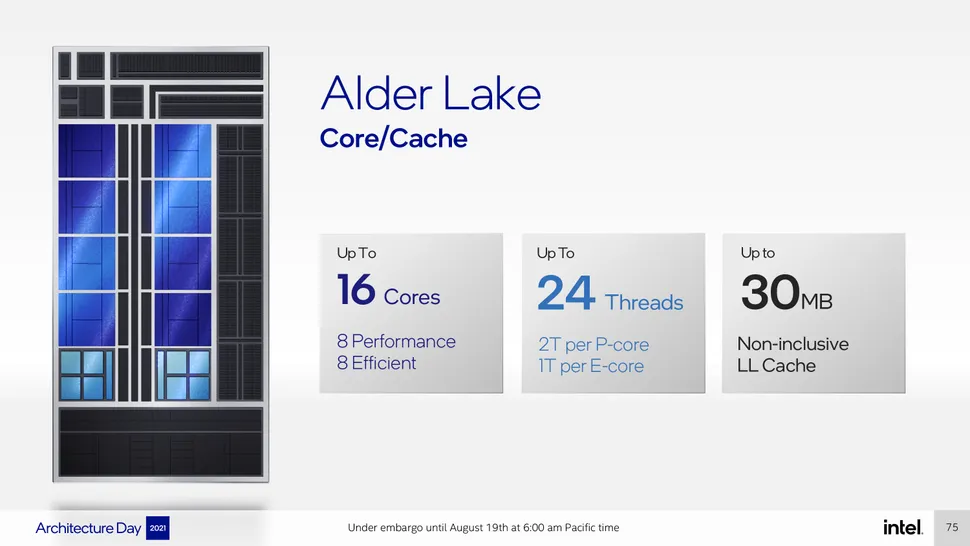Based on the 11th gen CPUs with the exact same iGPU costing zero to negative amount of money more?
We all know pricing is highly variable right now, and street pricing is all over the place in ways that often makes no sense whatsoever. Usually when the F part is more expensive than the non-F, it's because the F part is being sold at some elevated price that nobody should pay, while the non-F is still near MSRP
But, the MSRP of the non-F 11th gen processors is indeed $25 higher than the F parts.
I believe Intel exec is going to look at a $150 GT 1030 and think "our iGPU is about that good, lets get in on that action".
Intel is very clearly stating up to and is even telling you that it's 8+8
Do you think that your parents are going to understand that difference when they see a giant "16 Core" sticker on a computer at best buy, or are they going to think that this new computer is exactly twice as good as an 8 core processor? We still don't even know that 8+8 is even an accurate statement, because there is only implication that all cores can run at once, not any kind of proof or confirmation.
You have no amount of idea on how this will perform or how it will be priced, for all you know it might outperform the 5950x and still retain the max intel desktop price of about $550 that the 11900k holds.
Obviously all I'm doing is making an educated guess. If you don't like analysis and speculation, then maybe don't click on pre-release media for anything ever.
Also they did show what kind of real world performance you can expect from them.
That chart is 100% my point when I call the Intel presentation misleading smoke and mirrors. This is one of the charts that bothers me deeply.
That is not a performance claim, it is an efficiency curve. They put the word performance on the chart 5 times to make you think it is about performance, but it is not about performance. If you think this chart is a performance claim, then they have succeeded in misleading you.
They want to lead you into thinking that the small cores will either be 80% more performant than Skylake, or that the cores will have the same performance as maxed-out Skylake while using far less power (Really, intel probably wants you to think the cores will be both at the same time).
But think about what skylake (assuming 6th gen) actually was. An i5-6600k was a 95W 4c/4t part. So you're looking at around 20+ Watts per core at the high side of that curve. If Intel were running 8 E cores at 20 Watts per core, then that would be a part that runs in the rough ballpark of ~180 Watts before even considering the 8 full P cores. Of course, Intel is actually comparing it to their 2C/4T parts, which were closer to 25W per core in desktop.
So, obviously, Alder Lake cannot possibly be running their E cores at anywhere close to the high end of that performance chart. They are implying a configuration that simply is not possible.
Even if they are running at 20% of that power for "same" performance, than you're talking on the scale of ~36 Watts which is still a very significant proportion of the power budget to take away from the big P cores.
Realistically, the E cores are mobile Atom cores, which are going to be allocated low Atom-like levels of power. It is likely going to vary a lot between different parts, but it has to be on the scale of 1-2W per core. Definitely not 20W, and likely not even 5W. So the overall performance must be somewhere in the extreme bottom-left of that efficiency curve, not the top-right.
Here's another way to think about it: They can fit 4 E cores in the space of 1 P core. If those 4 cores combined were more performant at multithreading than a single P core, then Alder lake would have been configured with far more E cores (Giving Intel the benefit of the doubt that all cores can be used simultaneously). We would possibly be seeing a 4P/24E/32T configuration to meet thread parity with a 5950X, for example. Since configurations emphasizing more E cores don't exist, it can be assumed that a single E core will have less than 25% of the performance of a P core.
So, for an E core to be as performant as Skylake, than a single P core will need to have 4x the performance of a single Skylake core. Nobody is expecting that to happen. So far it seems like the Alder Lake P cores will only incrementally improve single-core performance over Rocket Lake, which would put it at somewhere in the range of 1.6x-2x the single-core performance of 6th gen skylake.
This would put the upper limit of expected performance from an Alder Lake E core at around half the max performance of a Skylake core. Which is, again, the extreme lower-left of the efficiency curve (a little less than 3 lines up from the bottom of the chart, assuming this unlabeled graph starts at 0 and has a linear scale).
But again, this is all only an educated guess, based on an analysis of what intel is actually saying, as opposed to what they are implying.




